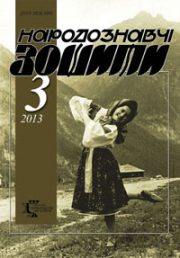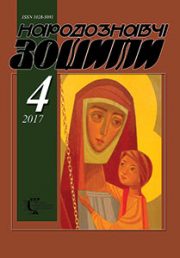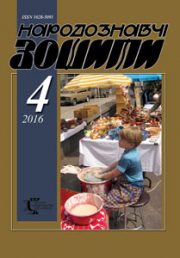The Ethnology Notebooks. 2025. № 4 (184), 948—955
UDK2-526.62:394.43(477)(477.86-21)
DOI https://doi.org/10.15407/nz2025.04.948
DUNDIAK Iryna
- ORCID ID: https://orcid.org/0000-0002-8175-479X
- Doctor of Art History, Professor,
- Professor of Design and Theory of Art,
- Vasyl Stefanyk Precarpathian National University,
- 57, Shevchenka Str., 76000, Ivano-Frankivsk, Ukraine,
- Contacts: e-mail: iryna.dundiak@pnu.edu.ua
SEMCHUK Lesia
- ORCID ID: https://orcid.org/0000-0002-3209-3585
- Candidate of Art History, Associate Professor,
- Associate Professor of Design and Theory of Art,
- Vasyl Stefanyk Precarpathian National University,
- 57, Shevchenka Str., 76000, Ivano-Frankivsk, Ukraine,
- Contacts: e-mail: lesia.semchuk@pnu.edu.ua
Abstract. Introduction.The article is devoted to cultural and artistic events related to the coronation of the icon of the Mother of God of Stanislav. The importance of the miraculous icon of the Mother of God Stanislaviv among Ukrainian crowned miraculous icons is analyzed. The history of its origin, re-finding, wonderful rescue is covered in detail. Iconographic features of the icon of the Mother of God Stanislaviv are distinguished among the well-known copies of the Czestochow miracle icon.
The main milestones of the historical life of the icon in temples (the Armenian Church of Ivano-Frankivsk for three centuries, and later in the church in Gdansk) are covered in detail. The history of the holidays associated with this icon is outlined, the stories of numerous wonderful recovery are briefly defined: the faithful were healed from terrible ailments, found spiritual support. A positive impact on the urban community was noted that the city was actually under the cover of the Mother of God and was a rather large vacation place.
The process of preliminary preparation for recognition of the icon is detailed. In 1937, the icon of the Mother of God Stanislavivs was crowned. The article briefly outlines the tradition of coronation of miraculous icons that existed in Western Ukraine since the seventeenth century. Such a rite spread in the seventeenth century by the countries of Western Europe, and in the seventeenth century in the territories of modern Ukraine. It is emphasized that the coronation in Stanislaviv became the largest event in the city of the twentieth century. By mass of visit. The organization of the action, its artistic design was one of the best for coronation of the time. The authors note the special spiritual and artistic significance of the shrine for the city, which should be restored and attempted to organize at least the temporary stay of this icon in Ivano-Frankivsk.
Keywords: miraculous icon, iconography, icon coronation, Mother of God Stanislavivska, iconography, Ivano-Frankivsk.
Received 20.06.2025
REFERENCES
- Yaremchuk, S. (2020). Religious practices in modern society: institutional context: monograph. Chernivtsi: Chernivets. nats. un-t im. Yu. Fed’kovycha [in Ukrainian].
- Miliaieva, L. (1994). Ukrainian Miraculous Icons of the Mother of God in the Orthodox and Catholic Tradition. Al’manakh’94 LAM. L’viv (Pp. 92—96) [in Ukrainian].
- Levyts’ka, M. (2017—2018). Crowned icons of the Virgin Mary in the Ukrainian Union tradition of the 18 th—19 th centuries (iconography and samples). Karpaty: liudyna, etnos, tsyvilizatsiia (Issue 7—8, pp. 270—284) [in Ukrainian].
- Dundiak, I. (2005). Artistic features of Western Ukrainian church processions of the 17 th—18 th centuries. Visnyk Prykarpats’koho universytetu. Mystetstoznavstvo (Vol. VII, pp. 28—35) [in Ukrainian].
- Vyhodnik, A. (1998). The plot of «The Coronation of the Virgin Mary» on Volyn icons of the 17th—18th centuries (based on monuments from the collection of the Volyn Museum of Local Lore and operating churches of Volyn). Volyns’ka ikona: pytannia istorii doslidzhennia ta restavratsii. Luts’k (Pp. 85—90) [in Ukrainian].
- Remeniaka, O. (2017). Icons of the Virgin Mary of Czestochowa and Chelm as evidence of the cultural community of Poland and Ukraine. Mystetstvoznavstvo Ukrainy (Pp. 190—197) [in Ukrainian].
- Bondariev, I. The icon of Stanislaviv. Retrieved from: https://report.if.ua/uncategorized/Stanyslavivskyj-obraz/ (Last accessed: 29.05.2025).
- Khrabatyn, N. The Greatest Shrine of the City of the Virgin Galician Correspondent. Retrieved from: https://gk-press.if.ua/x3555/ (Last accessed: 25.09.2024).
- Zukiewic, Konstanty Maria. (1937). Souvenir of the Coronation of the miraculous image of the Mother of God in the Armenian church in Stanisłaviv on May 30, 1937. Published by the Coronation Committee of the Miracle of the Image of the Blessed Virgin Mary of Grace in Stanisłaviv. St. Chowaniec [in Polish].






